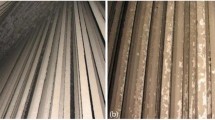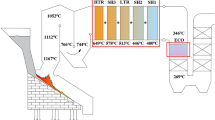Abstract
Spraying concentrated leachate into an incineration furnace and burning is encouraged by the Chinese government as a harmless method for leachate treatment. In this research, the constituent transformation mechanism was studied, by X-ray diffraction (XRD), scanning electron microscopy (SEM), and energy-dispersive spectrometry (EDS), of residues after burning the concentrated leachate in a muffle furnace at different temperatures (750 °C, 850 °C, 900 °C, 1000 °C, and 1100 °C). XRD results showed that the main components of the residues were metal chlorides and calcium salt crystals and that the peak position of most of these crystals changed little because their crystal structure was stable at high temperatures. SEM results illustrated that the higher the burning temperature, the smaller the solid particles, and the looser the structures of the residues. EDS analysis showed that S atoms in the concentrated leachate were usually transformed into gaseous compounds during incineration, whereas most of the Cl atoms could be fastened onto solid residues if an appropriate temperature was maintained. This study concluded that 900 °C was the best burning temperature for spraying concentrated leachate into the furnace. In addition, this study suggested that material selection for the nozzle and flue gas pipelines must pay more attention to corrosion caused by gaseous sulfur compounds. Similarly, material selection for the inner wall of the incinerator furnace should pay more attention to corrosion caused by Cl atoms. This means that the municipal solid waste (MSW) incineration power plants should incorporate various and appropriate corrosion-resistant materials according to the different regions of the incinerator.







Similar content being viewed by others
References
Dang Y, Lei YQ, Liu Z, Xue YT, Sun DZ, Wang LY, Holmes DE (2016) Impact of fulvic acids on bio-methanogenic treatment of municipal solid waste incineration leachate. Water Res 106:71–78
de Morais JL, Zamora PP (2005) Use of advanced oxidation processes to improve the biodegradability of mature landfill leachates. J Hazard Mater 123:181–186
Di Palma L, Ferrantelli P, Merli C, Petrucci E (2002) Treatment of industrial landfill leachate by means of evaporation and reverse osmosis. Waste Manag 22:951–955
Environmental Protection Agency of China (2014) Standard for pollution control on the municipal solid waste incineration (GB 18485-2014)
Guo J (2013) Feasibility of waste leachate sprayed back into incinerator. Environmental Sanitation Engineering 21:22–26 ( in chinese).
He R, Wei XM, Chen M, Su Y, Tian BH (2016) Effects of concentrated leachate injection modes on stabilization of landfilled waste. Environ Sci Pollut Res 23:3333–3341
Hseu ZY (2004) Evaluating heavy metal contents in nine composts using four digestion methods. Bioresour Technol 95:53–59
Liu YS, Zheng LT, Li XD, Xie SD (2009) SEM/EDS and XRD characterization of raw and washed MSWI fly ash sintered at different temperatures. J Hazard Mater 162:161–173
Long YY, Xu J, Shen DS, Du Y, Feng HJ (2017) Effective removal of contaminants in landfill leachate membrane concentrates by coagulation. Chemosphere 167:512–519
National bureau of statistics of China (2017) Chinese statistical year book
Ozkaya B (2005) Chlorophenols in leachates originating from different landfills and aerobic composting plants. J Hazard Mater 124:107–112
Ren X, Liu D, Chen WM, Jiang GB, Wu ZH, Song K (2018a) Investigation of the characteristics of concentrated leachate from six municipal solid waste incineration power plants in China. RSC Adv 8:13159–13166
Ren X, Liu D, Chen WM, Jiang GB, Wu ZH, Song K (2018b) Investigation of the characteristics of concentrated leachate from six municipal solid waste incineration power plants in China. RSC Adv 8:13159–13166
Talalaj IA, Biedka P (2015) Impact of concentrated leachate recirculation on effectiveness of leachate treatment by reverse osmosis. Ecol Eng 85:185–192
Wang YJ, Li XY, Zhen LM, Zhang HQ, Zhang Y, Wang CW (2012) Electro-Fenton treatment of concentrates generated in nanofiltration of biologically pretreated landfill leachate. J Hazard Mater 229:115–121
Wang GF, Lu G, Yin PH, Zhao L, Yu QJ (2016a) Genotoxicity assessment of membrane concentrates of landfill leachate treated with Fenton reagent and UV-Fenton reagent using human hepatoma cell line. J Hazard Mater 307:154–162
Wang HW, Wang YN, Li XY, Sun YJ, Wu H, Chen DL (2016b) Removal of humic substances from reverse osmosis (RO) and nanofiltration (NF) concentrated leachate using continudusly ozone generation-reaction treatment equipment. Waste Manag 56:271–279
Xu YD, Yue DB, Zhu Y, Nie YF (2006) Fractionation of dissolved organic matter in mature landfill leachate and its recycling by ultrafiltration and evaporation combined processes. Chemosphere 64:903–911
Xu YD, Chen CC, Li XD, Lin JY, Liao YX, Jin ZX (2017) Recovery of humic substances from leachate nanofiltration concentrate by a two-stage process of tight ultrafiltration membrane. J Clean Prod 161:84–94
Funding
This study was supported by Doctoral Innovation Fund Program of Southwest Jiaotong University (Fund number: D-CX201839).
Author information
Authors and Affiliations
Corresponding author
Additional information
Responsible editor: Philippe Garrigues
Publisher’s note
Springer Nature remains neutral with regard to jurisdictional claims in published maps and institutional affiliations.
Rights and permissions
About this article
Cite this article
Ren, X., Song, K., Xiao, Y. et al. Constituent transformation mechanism of concentrated leachate after incineration at different temperatures. Environ Sci Pollut Res 26, 34613–34621 (2019). https://doi.org/10.1007/s11356-019-06493-0
Received:
Accepted:
Published:
Issue Date:
DOI: https://doi.org/10.1007/s11356-019-06493-0




